Characterization of linkage disequilibrium, consistency of gametic phase and admixture in Australian and Canadian goats
- PMID: 26108536
- PMCID: PMC4479065
- DOI: 10.1186/s12863-015-0220-1
Characterization of linkage disequilibrium, consistency of gametic phase and admixture in Australian and Canadian goats
Abstract
Background: Basic understanding of linkage disequilibrium (LD) and population structure, as well as the consistency of gametic phase across breeds is crucial for genome-wide association studies and successful implementation of genomic selection. However, it is still limited in goats. Therefore, the objectives of this research were: (i) to estimate genome-wide levels of LD in goat breeds using data generated with the Illumina Goat SNP50 BeadChip; (ii) to study the consistency of gametic phase across breeds in order to evaluate the possible use of a multi-breed training population for genomic selection and (iii) develop insights concerning the population history of goat breeds.
Results: Average r(2) between adjacent SNP pairs ranged from 0.28 to 0.11 for Boer and Rangeland populations. At the average distance between adjacent SNPs in the current 50 k SNP panel (~0.06 Mb), the breeds LaMancha, Nubian, Toggenburg and Boer exceeded or approached the level of linkage disequilibrium that is useful (r(2) > 0.2) for genomic predictions. In all breeds LD decayed rapidly with increasing inter-marker distance. The estimated correlations for all the breed pairs, except Canadian and Australian Boer populations, were lower than 0.70 for all marker distances greater than 0.02 Mb. These results are not high enough to encourage the pooling of breeds in a single training population for genomic selection. The admixture analysis shows that some breeds have distinct genotypes based on SNP50 genotypes, such as the Boer, Cashmere and Nubian populations. The other groups share higher genome proportions with each other, indicating higher admixture and a more diverse genetic composition.
Conclusions: This work presents results of a diverse collection of breeds, which are of great interest for the implementation of genomic selection in goats. The LD results indicate that, with a large enough training population, genomic selection could potentially be implemented within breed with the current 50 k panel, but some breeds might benefit from a denser panel. For multi-breed genomic evaluation, a denser SNP panel also seems to be required.
Figures

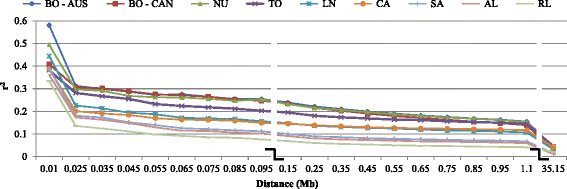
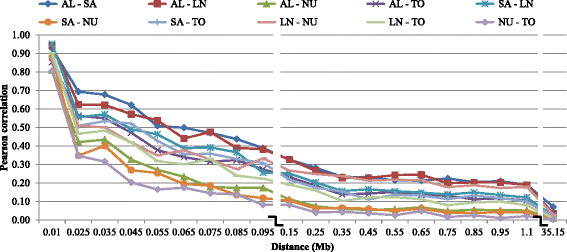
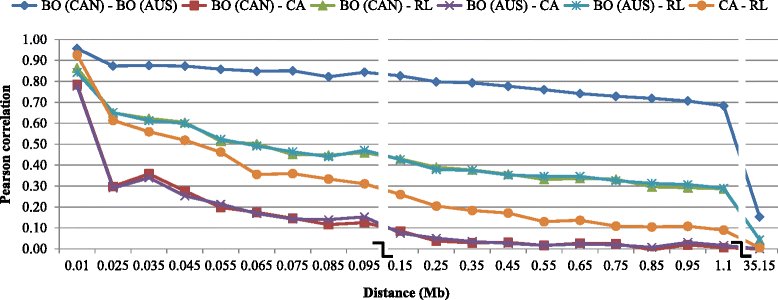
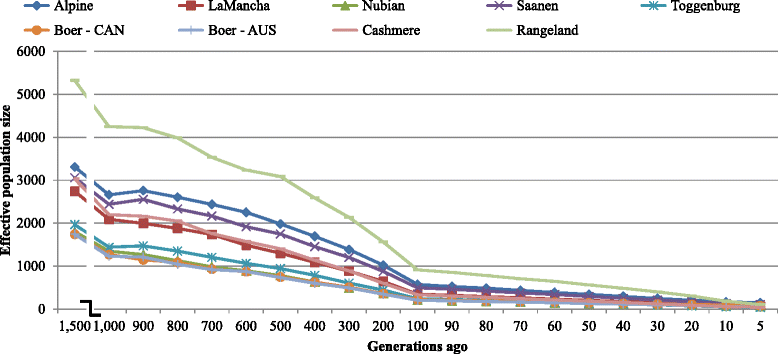
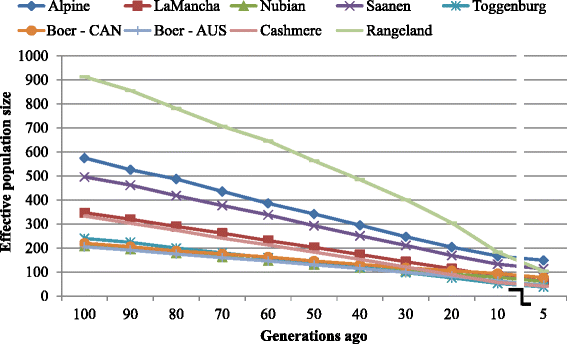
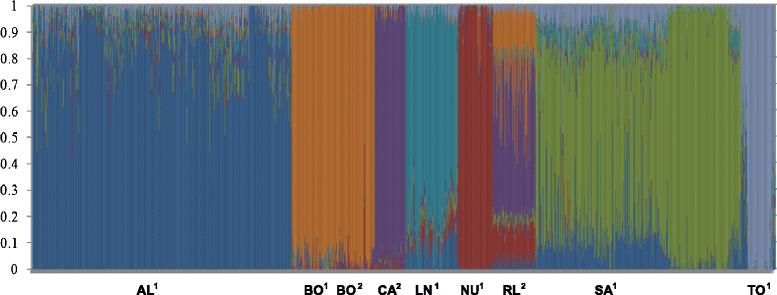
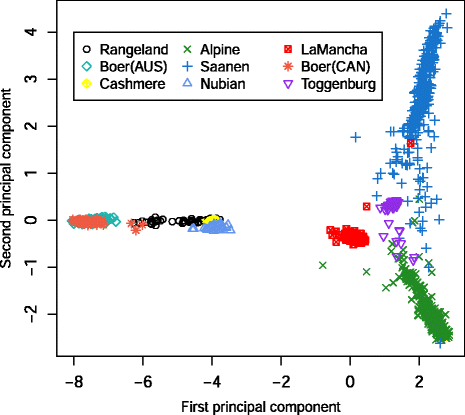
Similar articles
-
Population genomic structure and linkage disequilibrium analysis of South African goat breeds using genome-wide SNP data.Anim Genet. 2016 Aug;47(4):471-82. doi: 10.1111/age.12442. Epub 2016 Jun 15. Anim Genet. 2016. PMID: 27306145
-
Genetic diversity of a New Zealand multi-breed sheep population and composite breeds' history revealed by a high-density SNP chip.BMC Genet. 2017 Mar 14;18(1):25. doi: 10.1186/s12863-017-0492-8. BMC Genet. 2017. PMID: 28288558 Free PMC article.
-
Genetic diversity, extent of linkage disequilibrium and persistence of gametic phase in Canadian pigs.BMC Genet. 2017 Jan 21;18(1):6. doi: 10.1186/s12863-017-0473-y. BMC Genet. 2017. PMID: 28109261 Free PMC article.
-
Genomic advancements in goat breeding: enhancing productivity, disease resistance, and sustainability in India's rural economy.Mamm Genome. 2025 May 28. doi: 10.1007/s00335-025-10138-8. Online ahead of print. Mamm Genome. 2025. PMID: 40434651 Review.
-
Allelic association: linkage disequilibrium structure and gene mapping.Mol Biotechnol. 2009 Jan;41(1):83-9. doi: 10.1007/s12033-008-9110-3. Epub 2008 Oct 8. Mol Biotechnol. 2009. PMID: 18841501 Review.
Cited by
-
Associations of Blood Analysis with Feed Efficiency and Developmental Stage in Grass-Fed Beef Heifers.Animals (Basel). 2018 Aug 2;8(8):133. doi: 10.3390/ani8080133. Animals (Basel). 2018. PMID: 30072590 Free PMC article.
-
Genetic Characterization and Population Connectedness of North American and European Dairy Goats.Front Genet. 2022 Jun 17;13:862838. doi: 10.3389/fgene.2022.862838. eCollection 2022. Front Genet. 2022. PMID: 35783257 Free PMC article.
-
New world goat populations are a genetically diverse reservoir for future use.Sci Rep. 2019 Feb 6;9(1):1476. doi: 10.1038/s41598-019-38812-3. Sci Rep. 2019. PMID: 30728441 Free PMC article.
-
The Valdostana goat: a genome-wide investigation of the distinctiveness of its selective sweep regions.Mamm Genome. 2017 Apr;28(3-4):114-128. doi: 10.1007/s00335-017-9678-7. Epub 2017 Mar 2. Mamm Genome. 2017. PMID: 28255622
-
The Evolution and Role of Molecular Tools in Measuring Diversity and Genomic Selection in Livestock Populations (Traditional and Up-to-Date Insights): A Comprehensive Exploration.Vet Sci. 2024 Dec 6;11(12):627. doi: 10.3390/vetsci11120627. Vet Sci. 2024. PMID: 39728967 Free PMC article. Review.
References
Publication types
MeSH terms
LinkOut - more resources
Full Text Sources
Other Literature Sources
Research Materials
Miscellaneous

